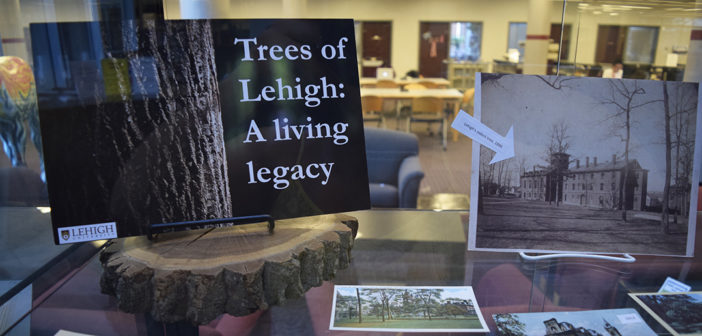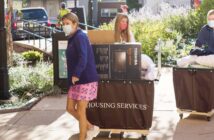The oldest tree on Lehigh’s campus is twice as old as the university itself.
A new exhibit in the lobby of the Fairchild-Martindale Library features the history of significant trees and forestry on Lehigh’s campus.
“Since it was founded, I think Lehigh has really paid attention to making this a beautiful campus and making it a campus of beautiful and diverse trees for people to enjoy,” said Stacey Kimmel-Smith, the Library and Technology Services assistant director.
The exhibit was put together with the help of ecology professor Robert Booth, in collaboration with Kimmel-Smith and Ilhan Citak, the librarian of archives and special collections.
“Lehigh has a lot of interesting history when it comes to natural areas that most people don’t know about,” Booth said.
The exhibit displays Lehigh’s long-lost arboretum, which was created in 1908 and forgotten in the 1950s.
“In 1908-1909, Robert Hall, who was the first biology professor here at Lehigh basically convinced the university to buy a piece of land on South Mountain and turn it into an arboretum,” Booth said.
Hall later convinced the university to put in an experimental forest in 1915, which is a man-made spot to experiment by growing different types of trees that wouldn’t normally grow in Pennsylvania, he said. The experimental forest is also featured in the exhibit.
Although it was created in the early 20th century, the experimental forest still houses some Southern trees that would not normally be found in Northern America, like the Carolina Silverbell and the Umbrella Magnolia, he said. The experimental forest was forgotten in the 1950s, but was recently rediscovered and is now being incorporated into Booth’s curriculum.
“Now, I take my ecology class up there every fall since we rediscovered it in 2011 and we basically have been resurveying all of the original plots in the experimental forest, looking at what’s happened after 100 years,” he said.
Booth said former Lehigh student Michelle Spicer wrote her master’s thesis on the impact of planting in the experimental forest on tree diversity in the area, since many of the original trees that were planted still exist there today. Some of Spicer’s work, which concluded the experimental forest still has more diversity than a natural Pennsylvania forest, is featured in the exhibit as well.
In addition to featuring Lehigh’s long-lost arboretum and experimental forest, the exhibit features information about the oldest tree on campus, a 300-year-old oak just outside of Christmas-Saucon, Lehigh’s oldest building. It also features information about new trees being planted in South Bethlehem by Lehigh students who, Kimmel-Smith said, have been involved in planting trees.
The exhibit showcases all that students have done to plant new trees, as well as repurpose fallen trees in Bethlehem by featuring information about the projects being done by Lehigh students with the trees that fell during Hurricane Sandy.
Elana Abrams, ’18, was one of the Lehigh students involved in one of those projects, which made a table for Alumni Memorial out of the fallen oak and walnut trees.
“It’s kind of interesting to think of how far back in Lehigh’s history they have been here,” she said. “Now we’re incorporating them back into the school, so they never really left.”
Lehigh students are coming together to construct a total of six Alumni Memorial welcome desks, two conference tables for Williams Hall, a coffee table to go in President John Simon’s house and two or three more projects coming up this year, Abrams said.
She said that they did everything from repurposing the wood to creating the design to make sure it fit in nicely with its surroundings in the Alumni Memorial Building. These tables fit in perfectly into the FML exhibit as it shows Lehigh’s close connection to the trees on our campus.
“There’s been a lot of cultivation of different and unusual species and maintenance of the trees has been ongoing really since the university was founded,” Kimmel-Smith said.






Comment policy
Comments posted to The Brown and White website are reviewed by a moderator before being approved. Incendiary speech or harassing language, including comments targeted at individuals, may be deemed unacceptable and not published. Spam and other soliciting will also be declined.
The Brown and White also reserves the right to not publish entirely anonymous comments.